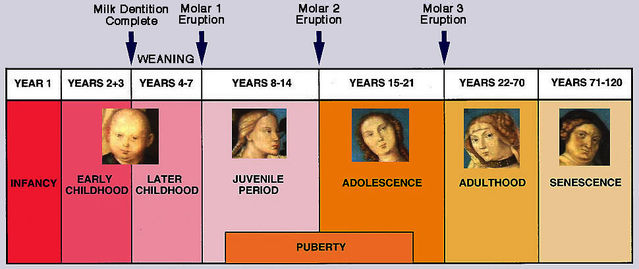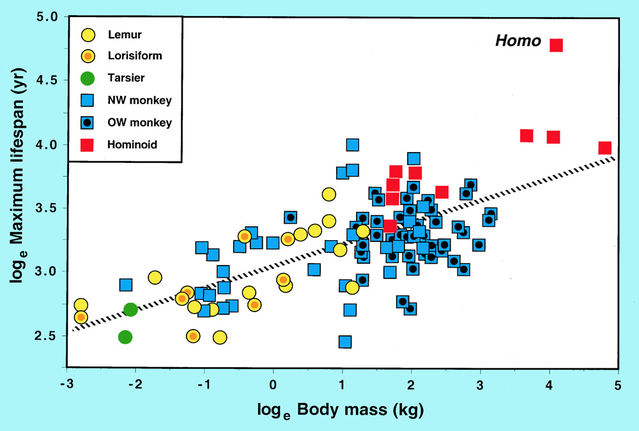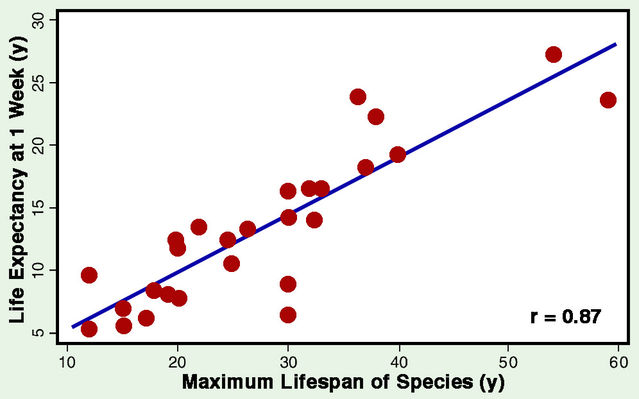Child Development
Pandora’s Pillbox: The Age-Old Quest for Longer Lives
Biological constraints and the dream of extended lifespans
Posted November 23, 2016

Aldous Huxley’s 1939 novel After Many a Summer Dies the Swan portrays Hollywood tycoon Jo Stoyte, past 60 and terrified by the prospect of death. Stoyte engages personal physician Dr. Sigmund Obispo to investigate longevity and they eventually travel to England to see the 201-year-old Fifth Earl of Gonister. The upside is that Gonister has achieved immortality by swallowing carp guts; the downside is his ape-like condition. Stoyte nonetheless wants the treatment. Huxley’s satire taps into age-old hopes for longer lives and perhaps even immortality. But what are the biological realities?
Early perceptions of human lifespans

The Old Testament of the Christian Bible gives three versions of human longevity. Adam and the other patriarchs reportedly lived for around nine centuries, Psalms 90:10 sets the bar considerably lower with "threescore years and ten”, while Genesis 6:3 lies between: “My spirit shall not abide in mortals forever, for they are flesh; their days shall be one hundred and twenty years.” Biblical patriarchs aside, one reason for such disparity is confusion between average and maximum survival. Quite possibly, most people in the biblical Near East died before 70, while 120 was close to the maximum.
The number seven has been a recurring theme in portrayals of the human lifespan. An early example is Hans Baldung Grien’s masterpiece Seven Ages of Woman. Shakespeare’s As You Like It provides a male counterpart, with discontented nobleman Jaques listing “seven ages of man”: infant, schoolboy, lover, soldier, justice, pantaloon, second childhood. Modern biology also recognizes seven, albeit rather different, stages: infancy, early childhood, later childhood, youth, adolescence, adulthood, and old age.

Is human longevity limited?
Some investigators have concluded that the human lifespan has a fixed upper limit, while others have inferred that its maximum length can be increased. Global increases in life expectancy throughout the 20th Century have convinced many that the human lifespan is unbounded. In 2000, detailed research by John Wilmoth and colleagues showed that in Sweden maximum age at death increased from 101 years in the 1860s to 108 during the 1990s. Most of that increment is attributable to reduced mortality for people over 70. Wilmoth and colleagues concluded that “reductions in death rates at older ages … seem likely to continue and may gradually extend the limits of achieved human longevity even further”.
An opposing interpretation, championed particularly by Jay Olshansky and Bruce Carnes in their 2001 book The Quest for Immortality, is that human longevity has a fixed biological limit. They propose that a certain level of inherent mortality will remain even if we radically reduce or eliminate all external causes. One reason for this divergent viewpoint is the difference between the greatest lifespan achieved at any time and the maximum possible. Technological and medical advances have permitted average life expectancy to climb steadily in developed nations. But has maximum possible longevity increased in tandem?
Probing the upper limit
In their 2000 paper, Wilmoth and colleagues showed that reported maximum lifespan increased progressively over the 130 years covered. However, records indicate only the longest lifespan achieved in any one year, not maximum possible longevity. Applying mathematical modelling to 1950-2005 life tables for Swedish women, researchers Byung Mook Weon and Jung Ho Je subsequently estimated maximum possible longevity. Their results, reported in 2009, pointed towards an upper limit of about 125 years. They also calculated that in modern industrialized populations the probability of survival is now close to its maximum.
Those theoretical estimations have just received empirical support from a global analysis of demographic data by Xiao Dong and colleagues. Remarkably similar patterns across 40 countries and territories show a steady increase in the proportion of individuals surviving beyond 70. However, Dong and colleagues consistently found that the rate of improvement in survival peaks at age 100 and then declines. Age at death for the world’s oldest individuals yields a similar result: having increased rapidly between 1970 and 1995, it then stabilized at about 115. The authors concluded: “Our results strongly suggest that the maximum lifespan of humans is fixed and subject to natural constraints.”
Why are we not immortal?
Efforts to extend the human lifespan culminate in a quest for immortality. Woody Allen encapsulated the hopes of many: “I don't want to achieve immortality through my work. I want to achieve it through not dying.” Senescence and death are seemingly inescapable facts of human existence. But why are we not immortal? Peter Medawar’s 1952 book An Unsolved Problem of Biology tackled this fundamental issue, which still awaits resolution. Various other organisms continuously propagate themselves and are potentially immortal. Individuals may succumb to predators or disease but never die of old age. So it is puzzling why humans and many other many-celled animals do not survive indefinitely.
One simplistic view is that senescence is the unavoidable consequence of accumulated wear and tear. As George Williams noted in a seminal 1957 paper, this stems from a facile analogy with disintegrating human artifacts. Unlike washing machines, however, living organisms have self-repair mechanisms. So why should deterioration be inevitable? Williams proposed that evolution has built senescence into our genetic make-up.
Theories of aging fall into two broad categories. Error theories are based on chance accumulation of damage to the body’s tissues. Other theories, by contrast, rest on the notion that ageing has been pre-programmed by evolution. Regulation by biological clocks across the lifespan is attributed to changes in expression of genetic systems governing maintenance, repair and defence. A central tenet is that natural selection should generally weaken with age. Ageing may have evolved because largely random external causes of mortality — notably predation, disease and accidental death — gradually reduce the likelihood that an individual will remain alive. Because external causes of mortality eventually kill, regardless of resources committed to bodily repair, ageing occurs as a by-product of investing in breeding rather than upkeep. Tom Kirkwood’s “disposable soma” theory of ageing proposes that pre-programmed mortality reflects reduction in energy costs of regulating errors in cells. He was particularly struck by the fact that cultured human fibroblast cells have a finite lifespan, constrained to about 60 cell divisions. Moreover, survival of cultured cells declines with donor age, indicating that an internal clock has been ticking away.

A testable prediction
An alternative view favoured by Peter Medawar is that late-acting deleterious mutations may accumulate because selection against them is weak. Consider a population of potentially immortal individuals whose fertility does not decline over time. Some individuals will still be eliminated because of factors such as predation and disease. External mortality risks are present throughout life and cumulative, so older age classes contain fewer survivors. Young age groups therefore make a greater contribution to the next generation. Selection against deleterious mutations that come into play late in life, affecting relatively few older individuals, will be weak, so they may become more prevalent over time. A distinct advantage of Medawar’s theory is this testable prediction: Species naturally subjected to high mortality levels from external causes should age more rapidly and die younger. The predicted relationship between mortality and lifespan is indeed found after allowance for body size. Compared to other mammals, primates have notably long lifespans, probably because their typical tree-living habits reduce mortality. Accordingly, the unusually long human lifespan indicates that we are biologically adapted for particularly low mortality.

Life-history patterns
A human lifespan is not just a row of milestones between birth and death. In all mammals, overall breeding capacity is determined by a pattern of features evolutionary biologists misleadingly call a “life-history strategy”. For any species, the intrinsic rate of natural increase — the outcome of life-history features — is a key indicator of breeding capacity. One of those features, longevity, is not easily documented under natural conditions, so biologists use the maximum value observed in captivity. In mammals, average life expectancy is generally about half maximum longevity.

At first sight, it might be expected that natural selection should always maximize breeding capacity. But there is a crucial difference between potential and actual reproductive success. Comparative studies have revealed instead that breeding capacity and lifespan are both adapted to fit natural mortality levels. And there is no reason why humans should be an exception.
Future prospects
Various investigators are actively exploring ways of extending the human lifespan. Laboratory experiments with animal models have shown that this is technically feasible. But this is a one-track approach to a complex biological problem, and potential side-effects (even if they do not include regression to an ape-like condition) have barely been considered. Moreover, mere extension of longevity without accompanying improvements in quality of life makes little sense. This is why demographers now consider “disability-free life expectancy”, the average number of years an individual is expected to live free of disability if current patterns continue to apply. For humans, immortality is almost certainly out of the question. Effective extension of maximum lifespan is a potential yet elusive goal. But rejuvenation is perfectly possible, as indicated by exciting new research into selective suppression of senescent cells with AGE monoclonal antibodies. I, for one, will happily settle for rejuvenation.
References
Austad, S.N. & Fischer, K.E. (1992) Primate longevity: Its place in the mammalian scheme. American Journal of Primatology 28:251-261.
Charnov, E.L. & Berrigan, D. (1993) Why do female primates have such long lifespans and so few babies? or life in the slow lane. Evolutionary Anthropology 1:191-194.
Dong, X., Milholland, B. & Vijg, J. (2016) Evidence for a limit to human lifespan. Nature 538:257-259. doi: 10.1038/nature19793
Doyle, N., Chouinard, L., Diallo, O.N., Smith, S.Y. & Gruber, L.S. (2015) Anti-Advanced Glycation Endproduct antibody (AGE) has the potential to inactivate senescence in aged CD-1 mouse. Paper presented at the 54th Annual Meeting of the Society of Toxicology, San Diego.
Gavrilov, L.A. & Gavrilova, N.S. (2001) The reliability theory of ageing and longevity. Journal of Theoretical Biology 213:527-545.
Gurven, M. & Kaplan, H. (2007) Longevity among hunter-gatherers: A cross-cultural examination. Population & Development Review 33:321-365.
Harvey, P.H. & Zammuto, R.M. (1985) Patterns of mortality and age at first reproduction in natural populations of mammals. Nature 315:319-320.
Kirkwood, T.B.L. & Austad, S.N. (2000) Why do we age? Nature 408:233-238.
Kohler, I.V., Preston, S.H. & Lackey, L.B. (2006) Comparative mortality levels among selected species of captive animals. Demographic Research 15:413-434.
Olshansky, S.J., Carnes, B.A. & Désesquelles, A. (2001) Prospects for human longevity. Science 291:1491-1492.
Weon, B.M. & Je, J.H. (2009) Theoretical estimation of maximum human lifespan. Biogerontology 10:65-71.
Williams, G.C. (1957) Pleiotropy, natural selection, and the evolution of senescence. Evolution 11:398-411.
Wilmoth, J.R., Deegan, L.J., Hundström, H. & Horiuchi, S. (2000) Increase of maximum life-span in Sweden, 1861-1999. Science 289:2366-2368.




